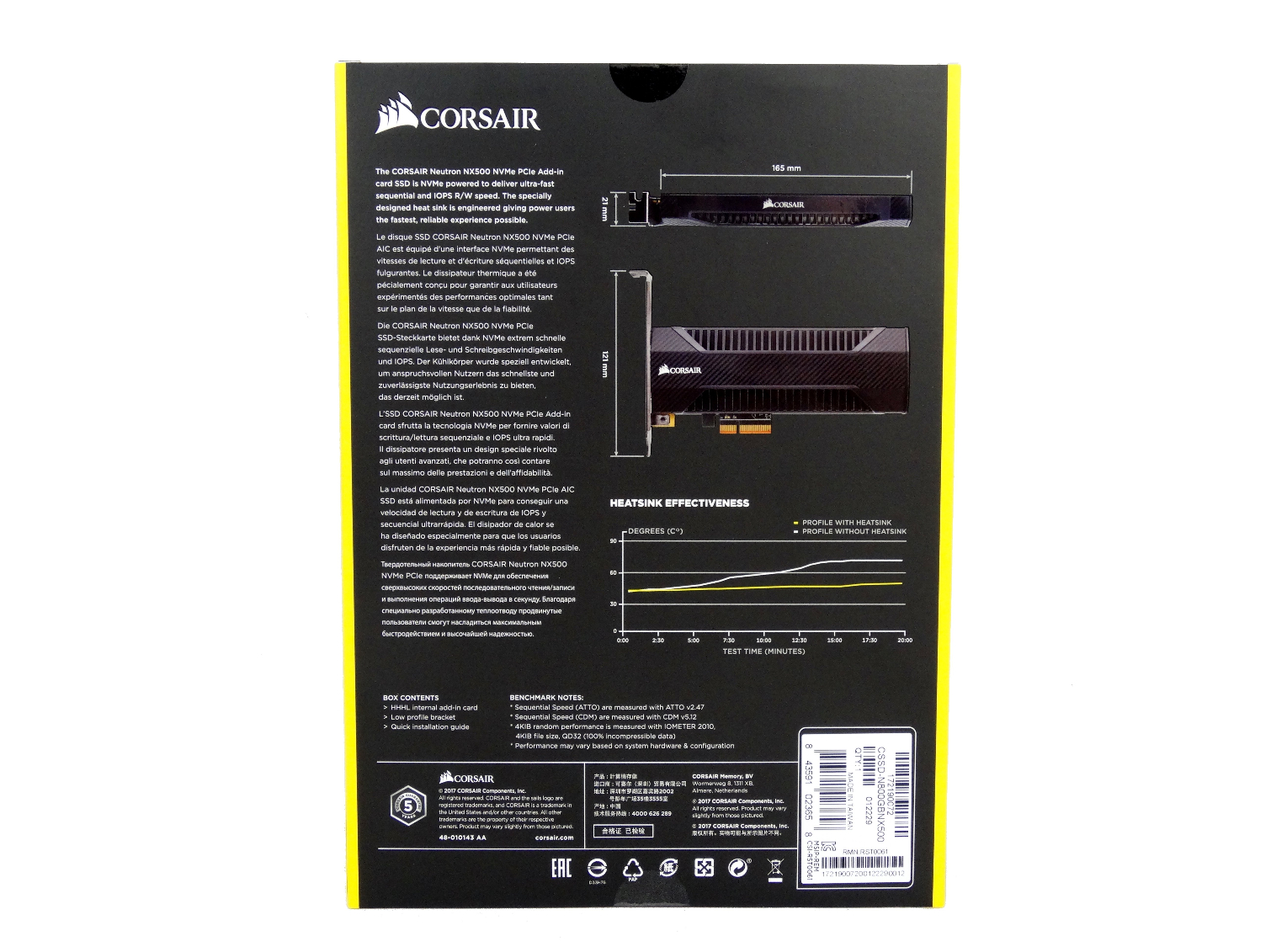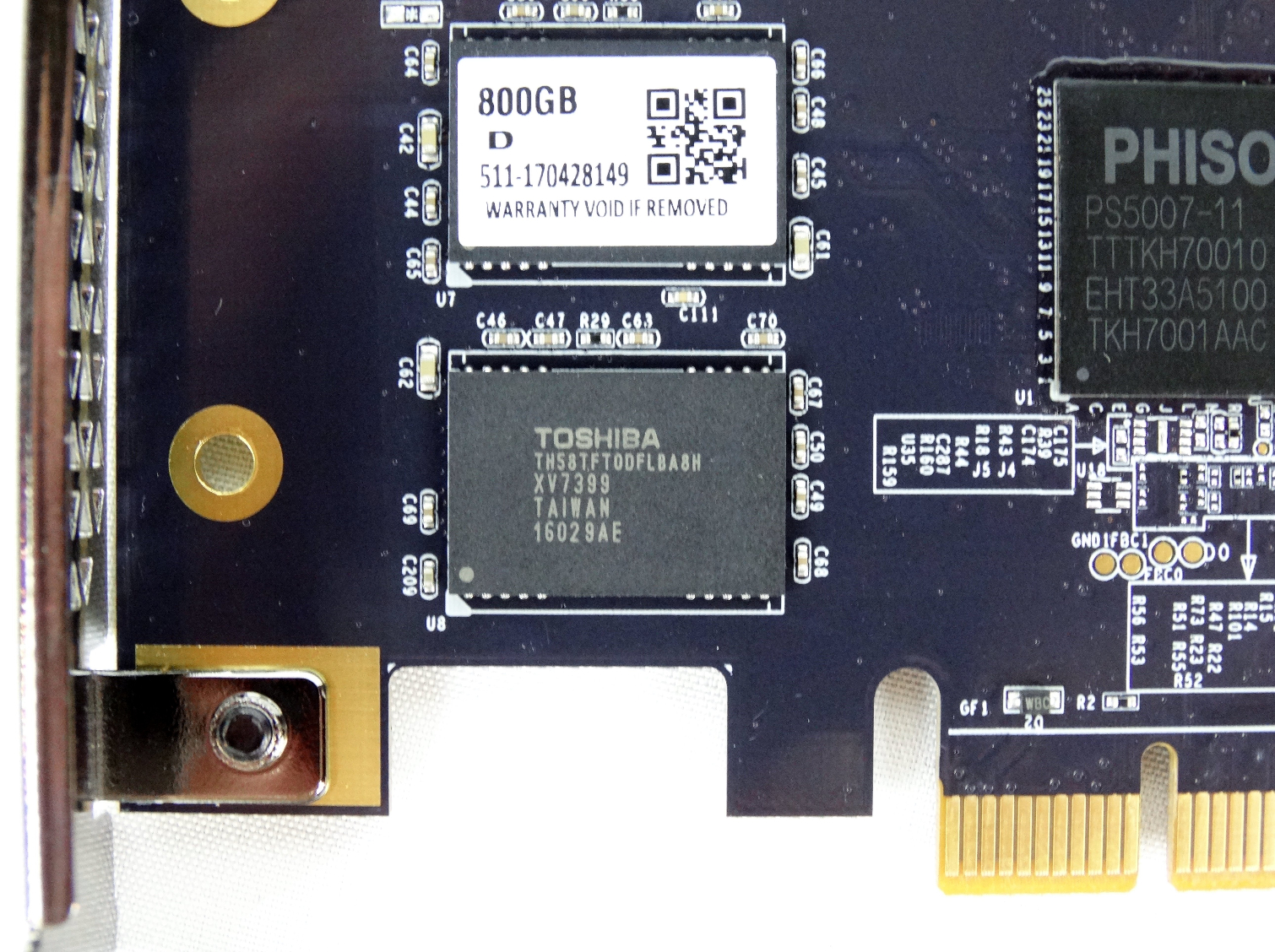Early Verdict
The Corsair Neutron NX500 400GB is faster than the 800GB model in many tests. Users will trade capacity for increased performance in heavy workloads, but the full-capacity Samsung Pro SSDs still dominate. The NX500 is just an ordinary SSD with desktop-class workloads, so unless you can unlock the available speed with heavy workloads, look for a lower-priced drive geared for desktop use.
Pros
- +
Better performance than the NX500 800GB due to firmware
- +
Corsair SSD Toolbox software
- +
Attractive design
Cons
- -
Expensive in an already expensive product class
- -
Lower application performance than others
- -
Weak low-QD performance
Why you can trust Tom's Hardware
Features & Specifications
Corsair's Neutron NX500 is the most refined consumer SSD to use the high-performance Phison PS5007-E7 NVMe controller. The new drive leverages the latest firmware, MLC flash technology, and a well-developed passive cooler to deliver the best performance we've seen from a Phison controller. The SSD is also the first 1TB Phison E7 drive to sell in the US and Europe. Corsair will not stop at 1TB, though. The company will have a massive 2TB option available in August to satisfy the needs of professional users and gamers alike.
Corsair already tapped the Phison E7 controller earlier this year for the very good Force MP500 M.2 SSD. The mainstream SSD shipped in 240GB and 480GB capacities, but at the time, putting a heat sink on an M.2 SSD was still rare (other than Plextor's M8PeGN). Some SSDs can throttle when you push them to read and write data for more than a few minutes at a time, but M.2 drives lack the PCB real estate for a robust cooling solution.
Add-in cards, on the other hand, are around the size of a mid-tier video card and provide much more surface area than the M.2 form factor. That means more room for passive and active cooling solutions. Coolers provide additional thermal headroom so the controller can stay active for longer periods of time without reducing clock speeds to throttle performance. In fact, it's possible for SSD controllers on add-in cards to draw more power to achieve higher clock speeds, but we've yet to see that in a retail product.
The four-core Phison PS5007-E7 features eight channels that communicate with the NAND. The controller thermal throttles at 90C, but some users have reported higher temperatures with extreme synthetic workloads. To be fair, Phison designed the controller to withstand these temperatures and uses several throttling steps to maintain high performance while reducing temperatures. The best way to keep this controller happy is to keep the system cool.
In our testing, we've found it doesn't take a massive cooler to ensure high performance. In our review of the Plextor M8Se, we found the M.2 model with a sliver-thin aluminum heat sink was sufficient enough to provide increased performance compared to the same drive without a heat sink. Not all controllers react the same way, but in our experience with SSD heat sinks, we found that a little really does go a long way.
Corsair's Neutron NX500 doesn't use a little bit of cooling to go a long way. The drive uses a lot of cooling to go all the way. You will not experience a thermal throttling incident if your system has a fan in it, somewhere, that circulates air. Corsair provided the chart above that outlines the NX500's temperature while it transfers data for 2,000 seconds. The controller never surpassed 50C.
There is more to the Neutron NX500 than just the cooler, though. The NX500 800GB wields 1024GB (1TB) of raw NAND under the cover, but the usable capacity is lower. The extra NAND provides an aggressive dose of overprovisioning to ensure high performance during demanding workloads. To date, the Galax HOF PCI-E 1TB is the only consumer-facing E7 SSD with 1TB of flash to come to market, and it was sold in Asia in very limited quantity. Even in Asia, it's considered a unicorn.
Get Tom's Hardware's best news and in-depth reviews, straight to your inbox.
There hasn't been an E7 with more than 1TB of capacity. We haven't even tested one in our lab even though we run some special reference designs through our test suite to measure the performance of proposed products. With that in mind, the Corsair Neutron NX500 1.6TB will be a very special product. You will have to wait at least a month to see the largest NX500 because Corsair doesn't have it ready for this review. We'll likely see it on display at the Flash Memory Summit.
Specifications


The Corsair Neutron NX500 will eventually have three capacity points. We've already discussed the 1.6TB and the 800GB, but the company will also introduce a more affordable 400GB drive. All the drives have raw capacities of 2TB, 1TB, and 512GB, but they also employ aggressive overprovisioning. Corsair uses the same amount of overprovisioning as enterprise drives designed for sustained heavy random workloads. The reserved flash is not user accessible, but it gives the controller more free space to handle background activity.
The four-core Phison E7 controller has the processing power to handle foreground and background activity without hurting the user experience. Unfortunately, the dual-core controllers we find on many mainstream and entry-level SSD products aren't as efficient. Overprovisioning also increases endurance. The free space is like having an extra piece of paper to work out math problems so you don’t clutter the exam with chicken scratches. The primary storage space says fresh and clean because most of the dirty work happens in the overprovisioning.
We only have specifications for the 400GB and 800GB SSDs that Corsair will ship at launch. In general, the two drives share identical performance specifications. The SSDs feature up to 3,000/2,400 MB/s of sequential read/write throughput. Random performance weighs in at 300,000/270,000 read/write IOPS.
We suspect the Corsair Neutron NX500 will be one of the last products released with Toshiba 15nm MLC. We've already tested the Toshiba XG5 with the new 64-layer 3D BiCS NAND. In the review, we noted there would be one last noteworthy product with 15nm planar MLC. If you aren't excited about moving to an all-TLC world, the NX500 might be your last-chance SSD.
Features
The PS5007-E7 is Phison’s first NVMe controller designed for high-performance applications. Here's the quick rundown;
Extreme Reliability
Multiple features are built into the PS5007-E7 to ensure stability and reliability.
- SmartECC – Reconstructs defective/faulty pages when regular ECC fails
- SmartRefresh – Monitors block ECC health status and refreshes blocks periodically to improve data retention
- SmartFlush – Minimizes time data spends in cache to ensure data retention in the event of power loss
Extreme Control
The Neutron NX500 SSD with Phison PS5007-E7 controller works with CORSAIR SSD Toolbox.
- Drive Monitoring – Monitor the health of your Force Series
- Secure Wipe – For security purposes, completely clear the drive of any recoverable data
- Firmware update – Install updated firmware as needed
We've tested products with the Phison E7 controller several times already. The NX500 is a little different than the other drives, though. This is the first E7 we've tested with the new 4.5 firmware. We just got our hands on 4.0 for another drive and found that Phison optimized the firmware for high performance. The new 4.5 firmware may be even better.
Pricing, Warranty & Endurance
Corsair hasn't announced the NX500 1.6TB's pricing, but we know the NX500 800GB retails for $649.99 and the 400GB model is $319.99.
The Neutron NX500 series comes with a limited five-year warranty. The generous write endurance specification limits the warranty. The NX500 400GB can absorb 698TB, and the 800GB model can survive 1,396TB and remain under warranty coverage. The warranty expires if you exceed the limits, but the drive doesn't just fall over and wave a white flag. The extended endurance comes from the heavy dose of overprovisioning. I'd say you get more endurance than you will ever use. The NX500 is one of, if not the last, consumer SSD with MLC NAND, so you might hold onto this drive for a bit longer than other products.
Accessories
The Neutron NX500 ships with a half-height bracket and a paper manual. The Corsair SSD Toolbox also supports the NX500 and allows you to monitor the drive's status as well as perform management tasks, like secure erase and TRIM.
Product Packaging



The Neutron NX500 is Corsair's first add-in card form factor SSD, so we haven't seen this type of package from the company before. The package is more like a video card box than one designed for an SSD. Corsair listed all the NX500 specifications and details. The company didn't overlook the inner package, either. The package has a nice graphic that tells buyers this is a premium product and not a commodity SSD tossed in a box.
A Closer Look




The Neutron NX500 is not a race-to-the-bottom product. This is Corsair's flagship model, and you can tell the company put some time and effort into the design. We found the reference E7 add-in card under the massive heatsink, but everything on the surface is custom. Corsair constructed the heat sink with two parts. A large aluminum cooler absorbs the heat from the E7 controller and a plastic covering wrapped in carbon fiber-look vinyl provides the aesthetic appeal. It's a nice look that will blend well with the Corsair carbon fiber computer case, should it actually come to market.
The only other E7-powered 1TB drive we've tested also has a shroud that covers the heat sink. The plastic on that drive degrades the cooling to the point that the heatsink becomes insulation. Corsair didn't make the same mistake with the NX500. There is enough exposed metal for the cooler to be effective.
Internals



The NX500 uses the Phison PS5007-E7 add-in card reference design. We've tested a number of these over the last two years, starting with the Zotac SONIX and a pair of special prototype engineering samples that served as the base design for this SSD.
Corsair used the fabled E7 with a full package surrounding the flip-chip controller. This is the first time we've had the packaged controller in the lab, and only the second time we've seen it. The additional surface area is easier to cool with a heat sink and adds a layer of protection. You can easily damage exposed chips, especially those as small as the E7 controller. I say that from experience after crushing at least a dozen Pentium III and Athlon XP cores over the years.
MORE: Best SSDs
MORE: How We Test HDDs And SSDs
MORE: All Storage Content

Chris Ramseyer was a senior contributing editor for Tom's Hardware. He tested and reviewed consumer storage.
-
AgentLozen Do you suspect that the nx500 is a victim of the NAND shortage, or is it's problem a bunch of dumb marketing and engineering decisions?Reply
Performance wise, it wasn't AWFUL. It definitely has a pricing problem though.
Good review. -
tom10167 It's reassuring that you guys didn't give the conclusion "This is really good!" when it clearly isn't. Honest reporting.Reply -
2Be_or_Not2Be Chris, I also appreciate the honest conclusion. This drive is at least better than the Intel 600p; however, the pricing really makes it lose any appeal for me. I would definitely go with Samsung for the performance.Reply -
coolbiker I wonder why they just didn't go with an m.2 option and then have an pci adapter. I'd almost expect most people wanting to buy this will have a board that will have at least one m.2 slot. I'm just not into using my express slots unless it need to be used.Reply -
caustin582 If you can't beat Samsung's performance and you're unwilling to beat their prices, why even bother?Reply


